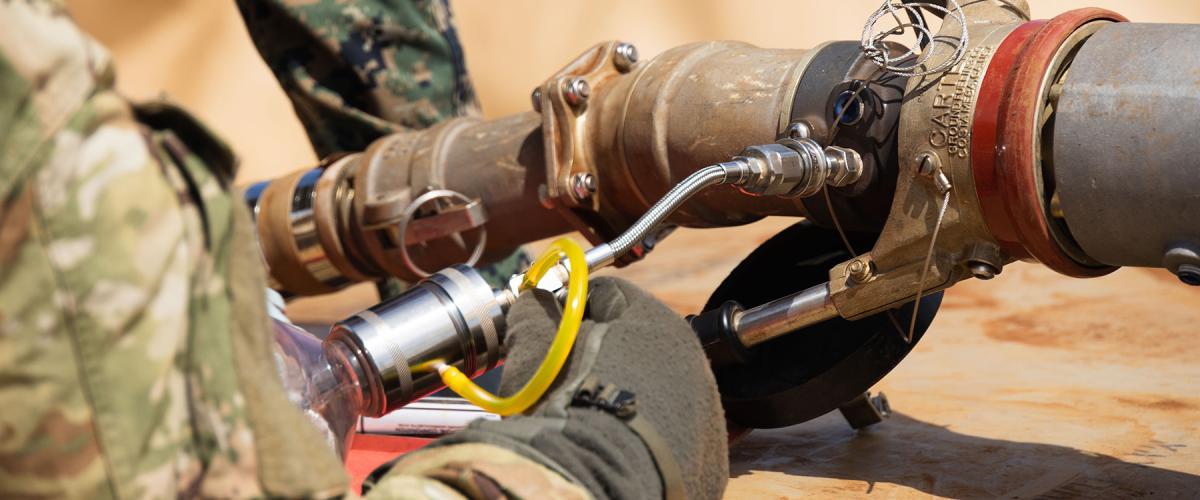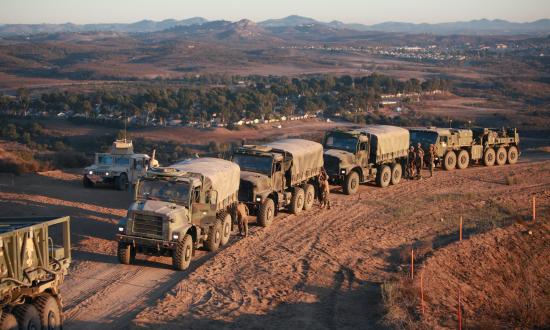Energy is one of the most important commodities for expeditionary forces. Throughout the 20th century, even advanced military forces have been limited by unreliable access to fuel. During World War II, for example, the German Wehrmacht repeatedly had to stop short of their objectives because they ran out of fuel, the Italian Reggia Marina spent most of the war in port because they did not have a reliable supply of bunker fuel, and chronic fuel shortages pushed the Imperial Japanese Navy to send both ships and airplanes on one-way sorties.1 Today, almost all the energy consumed by the military is petroleum-based. As the U.S. military—and the Marine Corps specifically—reorient on a potential great power conflict in the Pacific, ensuring reliable and secure access to operational energy for expeditionary forces must be a top priority.
New Challenges in Energy Sustainment
The U.S. military has had reliable access to fuel in recent years. During the invasion of Iraq in 2003, both the Army and the Marine Corps laid pipelines that reached back to ports or refineries in Saudi Arabia to carry fuel to the advancing forces. For later operations in Iraq and Afghanistan, while fuel delivery to remote outposts sometimes faced significant obstacles, and transportation costs could mean fully burdened prices up to a $1,000 per gallon, the challenges were almost always limited to the final leg of delivery. Fuel could flow unimpeded on military and civilian vessels to U.S. and allied supply depots.
Today, United States is a major oil and gas producer, with a refining capacity to match—a net energy exporter since 2019. It also has easy access to oil exports from Mexico and Canada. No organization has benefited more from this than the U.S. military, which consumed more than 130 million barrels of petroleum a year during the height of the wars in Iraq and Afghanistan and is the world’s single largest institutional consumer of petroleum products. In short, the U.S. military theoretically has access to all the petroleum it might need in a future conflict. The issue is the storage, transportation, and distribution of fuel that would be required to sustain expeditionary forces in a contested environment on the far side of the Pacific Ocean.
A major conflict in the Pacific would likely push U.S. logistics efforts to the breaking point, putting any expeditionary forces in the region in a precarious position. Senior Marine Corps leaders have emphasized that “logistics will be the pacing function for the Marine Corps” and, more specifically, that “fuel is the pacing commodity.” The service is so concerned about sustaining forces in the Pacific that it has added modules on foraging at The Basic School and revised Marine Corps Doctrinal Publication (MCDP) 4: Logistics for the first time since 1997.
Threats to supply lines stretch from the forward edge of the battlefield to the home front; however, the energy logistics chain is probably weakest as fuel is moved across the Pacific. Not only would the Chinese military target U.S. tankers, but the U.S. Navy and Maritime Administration have chronically underinvested in tankers and oilers that can move fuel in bulk, forcing the U.S. military to rely on the commercial sector. One expert summarized the state of the U.S. tanker fleet: “Not only does the U.S. lack the tonnage required to support a major conflict in the Pacific, it has no identifiable roadmap to obtain it.” On the storage side, outdated and poorly maintained facilities are vulnerable not just to attack and sabotage, but also to the effects of time and weather. Compounding the issue, the Navy recently began to defuel the Red Hill Bulk Fuel Storage Facility in Hawaii without a replacement, after fuel repeatedly leaked into the local water supply.
Warnings have flowed from experts inside and outside the Department of Defense. A 2019 report from the Center for Strategic and Budgetary Assessments found that “absent dramatic improvements, U.S. sealift forces would face major challenges and may fail to meet Joint Force demands in a major war.”2 The report found major deficiencies in the Navy’s projected ability to refuel its own ships, let alone sustain expeditionary forces. The situation has not improved since. Research from the Center for a New American Security reached similar conclusions, assessing that “the Department of Defense has systemically underinvested in logistics in terms of money, mental energy, physical assets, and personnel” and that, in conflict, Chinese forces likely would prioritize targeting U.S. logistics. Furthermore, the Navy has let the number of amphibious ships fall below both what is mandated by Congress and what is required by the Marine Corps, and continued disagreements have delayed acquisition of the new landing ship medium (LSM)—both of which hurt the ability to sustain expeditionary forces.
At the same time, energy consumption per deployed soldier or Marine continues to rise. In Afghanistan, the military averaged 22 gallons of fuel per deployed soldier per day, a 2,200 percent increase since World War II and a 175 percent increase since Vietnam. The introduction of more unmanned systems, communications gear, remote sensors, artificial intelligence, and computing or directed energy weapons—all heralded as key future tech—will require more and more energy at the tactical edge. Any significant deployment of small unmanned combat aerial vehicles by expeditionary forces will face challenges in fueling. Without significant changes, it will be difficult or impossible to meet the energy requirements of an expeditionary force in the Pacific.
A Multipronged Approach
There is no single solution to these challenges. The Marine Corps should look to new concepts, new fuels, and new platforms that together could ensure expeditionary or stand-in forces have access to the operational energy they will need in a Pacific fight.
The Marine Corps already has been leaning into new logistics concepts and doctrine, revising MCDP 4: Logistics for the first time in more than 25 years. Marines have put forward innovative ideas such as “21st-century foraging,” in which Marines sustain themselves through local procurement, and “regenerative logistics.” Another idea is “sleeper cell logistics,” in which units use prepositioned or cached supplies, sometimes hidden in plain sight. These ideas must be validated, experimented with, and fleshed out if they are to be as effective as promised.
The Marine Corps also should look to new and alternative fuels and energy sources. Synthetic fuels have a long history of military use, and the Air Force has certified all its aircraft to fly on a blend of synthetic and conventional petroleum fuels, potentially paving the way for greater use in the Marine Corps and other services. The main advantage of synthetic fuels is that they could be produced closer to where they are needed.
Hydrogen is another promising petroleum alternative. Not only are hydrogen fuel cell–powered vehicles more efficient, but they also have lower audible and thermal signatures than internal combustion engines. Further, recent advances in producing hydrogen with aluminum feedstock and water could open a path for forces to generate hydrogen fuel at the tactical edge of the battlefield. Small-scale nuclear power is another possibility.
The Department of Defense has two projects, one Army and one Air Force, working on micro-nuclear reactors that could power forward bases in austere environments.While not as well suited for stand-in forces, these reactors could be used to produce other fuels such as synthetic petroleum or hydrogen closer to the point of use and reduce or eliminate the need to transport fuel long distances. Innovation in the commercial sector may make electricity generation from solar, wind, and wave energy viable for operational use, which could provide another way for expeditionary forces to power their equipment.
Finally, new platforms could help ensure expeditionary forces have access to the energy they need. These platforms fall into two categories. The first are platforms that can help move fuel around the battlespace. Concepts such as expeditionary advanced base operations will push Marines to be more distributed; effective logistics requires not just moving fuel into the theater but also getting it to the forces that need it. The new LSM could be a critical connector for moving fuel into and around the first island chain, especially if dozens are acquired. Other innovative platforms such as dracones, unmanned barges, or semisubmersibles are low-cost, attritable options for moving bulk fuel.
The second category is platforms that will reduce expeditionary forces’ petroleum consumption. These are electric, hybrid, fuel-cell, or other types of systems that lessen the need to deliver fuel to forward forces. The Army and the Navy already have committed to acquire electric and hybrid vehicles for their tactical and nontactical fleets. Hybrid and electric vehicles are not only valuable in their own right because of they are more efficient and have lower audible and thermal signatures, but because they can serve as mobile energy reservoirs on the battlefield for generating electricity, storing it, and distributing it to smaller battery-reliant systems like radios, computers, and unmanned systems. Speeding their deployment and prioritizing tactical vehicles would help expeditionary forces stretch their operational energy further, as well as help manage and distribute power to systems that run off electricity instead of petroleum fuel.
Looking Forward
The logistics chain that stretches from a Marine detachment operating inside a weapons engagement zone back to oil wells and refineries in the United States can be attacked or degraded at any point, and adversaries have made it clear they see that logistics chain as a vulnerability. However, if the Marine Corps prioritizes operational energy and focuses on new concepts and doctrine, alternatives to petroleum-based fuels, and new platforms, it can turn operational energy from a vulnerability into an advantage. As the nation’s premier expeditionary force, the Marine Corps must lead the way on innovative expeditionary energy. It cannot afford to wait until a conflict begins.
1. Robert Gorlaski and Russel L. Freeburg, Oil & War: How the Deadly Struggle for Fuel in WWII Meant Victory or Defeat (New York: William Morrow and Company, 1987).
2. Timothy Walton, Ryan Boone, and Harrison Schramm, Sustaining the Fight: Resilient Maritime Logistics for a New Era (Washington, DC: Center for Strategic and Budgetary Assessments, April 2019), 76.






